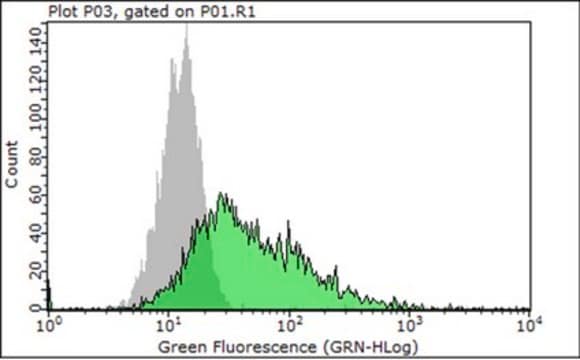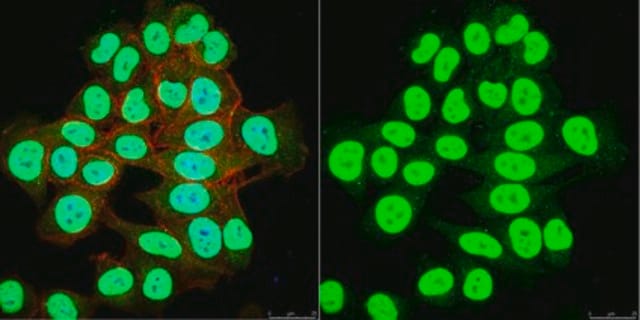MAB1998
Anti-Integrin α2β1 Antibody, clone BHA2.1
clone BHA2.1, Chemicon®, from mouse
Synonym(s):
VLA-2
About This Item
Recommended Products
biological source
mouse
Quality Level
antibody form
purified immunoglobulin
antibody product type
primary antibodies
clone
BHA2.1, monoclonal
species reactivity
human, canine, pig
manufacturer/tradename
Chemicon®
technique(s)
flow cytometry: suitable
immunohistochemistry (formalin-fixed, paraffin-embedded sections): suitable
immunoprecipitation (IP): suitable
isotype
IgG1κ
NCBI accession no.
UniProt accession no.
shipped in
wet ice
target post-translational modification
unmodified
Gene Information
human ... ITGA2(3673)
Related Categories
Specificity
Application
Cell Structure
Integrins
Immunoprecipitation: Immunoprecipitation of VLA-2 integrins from lysate of 10E6 cell equivalent requires 2-5 μg of BHA2.1
immunohistochemistry in frozen tissue sections: 5 μg/mL
Immunohistochemistry in paraffin sections: 1:50. Block endogenous peroxidase using 0.5% H202 in 80% ethanol, 30 min and unspecific reactions using NGS 1:5 in PBS, 20min RT. Bouin′s fixative solution has been used successfully. Incubation time, conditions: 24 h; 4°C; pretreatment: 0.1% trypsin, 30 min, 37°C. Intracytoplasmic staining near cell membranes.
Does not detect alpha2 integrin subunit by Western blot presumably due to conformational properties of the epitope involved. The epitope for BHA2.1 is dependent on the presence of the (I) domain of alpha2 integrin subunit and does not bind VLA-2 variant which lacks the I-domain.
Function Blocking: BHA2.1 inhibits VLA-2 mediated cell adhesion to collagen and laminin; complete inhibition can generally be achieved at a final concentration of 10 μg/mL.
Final working dilutions must be determined by end user.
Physical form
Storage and Stability
Analysis Note
Skin, CD4 & CD8 positive T cells
Other Notes
Legal Information
Disclaimer
Not finding the right product?
Try our Product Selector Tool.
Storage Class Code
10 - Combustible liquids
WGK
WGK 2
Flash Point(F)
Not applicable
Flash Point(C)
Not applicable
Certificates of Analysis (COA)
Search for Certificates of Analysis (COA) by entering the products Lot/Batch Number. Lot and Batch Numbers can be found on a product’s label following the words ‘Lot’ or ‘Batch’.
Already Own This Product?
Find documentation for the products that you have recently purchased in the Document Library.
Our team of scientists has experience in all areas of research including Life Science, Material Science, Chemical Synthesis, Chromatography, Analytical and many others.
Contact Technical Service






